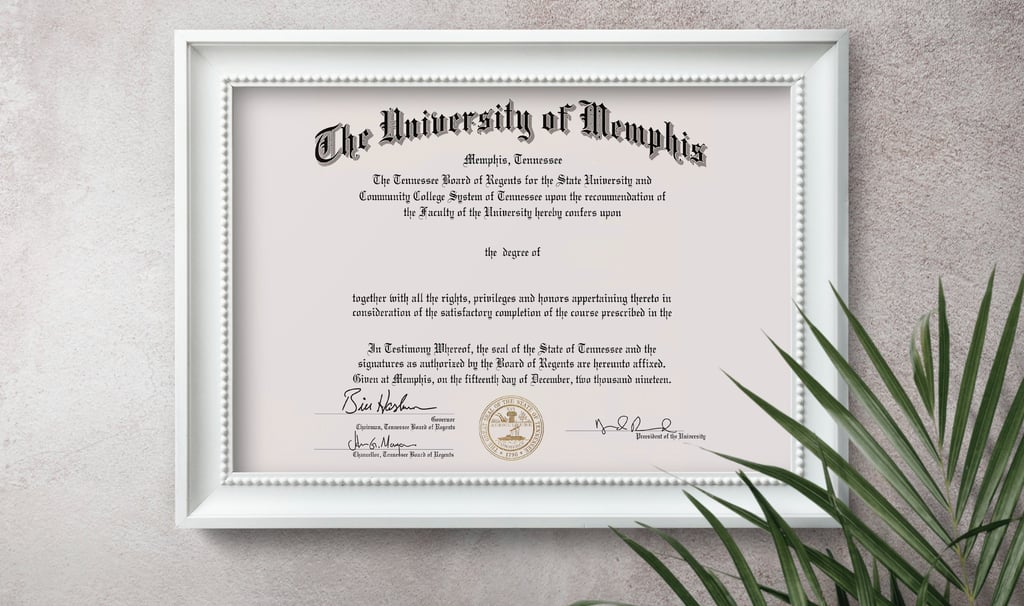How to Spot a Fake Diploma: Signs, Red Flags, and Verification Tips
In today's digital age, fake diplomas have become more common. With the rise of online printing services and diploma mills, counterfeit degrees can look strikingly similar to real ones. Whether you're an employer verifying credentials or an individual checking the authenticity of your own document, knowing how to spot a fake diploma is essential. This guide walks you through every step — from checking paper quality to verifying accreditation — to help you confidently identify fraudulent academic documents.


Scrutinizing the Details
The first clues to spotting fake diplomas often come from small details. Real diplomas use high-quality materials and precise printing that counterfeiters usually cannot copy perfectly. Start by checking the paper. Genuine diplomas are printed on thick, premium parchment or cardstock. Thin, glossy, or regular printer paper is a warning sign. Next, examine the text and fonts.
Look for uneven spacing, wrong fonts, or misaligned text. Spelling mistakes in words like "Bachelor" or "University" are clear signs of a fake. Authentic diplomas include signatures from authorized officials, often handwritten. Fake ones may have printed or copied signatures that look flat. Also, check for color inconsistencies or blurry logos, as real universities follow strict printing standards.
Analyzing the Design
Design is a critical way to spot a fake diploma. Real diplomas are usually simple, professional, and easy to read. Counterfeit diplomas, on the other hand, often try too hard to look "official" with extra decorations. Many forgers use elaborate calligraphy, multiple borders, or old Gothic fonts, thinking it makes the diploma appear more genuine.
Most universities, however, prefer clean, modern designs that focus on professionalism rather than decoration. Pay close attention to layout symmetry and logo accuracy. Compare the diploma with official images on the university's website or alumni pages.
Fake diplomas may show outdated logos, wrong seal placement, or mismatched colors. If you are unsure, contact the university's registrar or alumni office. They can confirm whether the design matches the official format and help verify the diploma's authenticity.
Verifying the Credentials
Looking at a diploma isn't always enough to tell if it's real. Verification is the most reliable way to confirm a degree's authenticity. Most accredited universities keep official databases or offer digital tools to check degrees. In the UK, HEDD (Higher Education Degree Datacheck) helps employers verify qualifications, while in the U.S., the National Student Clearinghouse provides similar services for degrees from accredited institutions.
It's also crucial to ensure the university is accredited correctly. Fake diploma sellers often claim accreditation from false agencies with professional-sounding names. Always verify accreditation through recognized education authorities or government databases to confirm the institution's legitimacy.
Check the address and contact details on the diploma. Fake diplomas may show unrealistic addresses or information that doesn't match the university's official website or postal codes, which is a clear warning sign of a counterfeit certificate.
Understanding Diploma Mill Tactics
One of the primary sources of fake diplomas is diploma mills, unaccredited institutions that sell degrees without coursework or exams. These fake universities often have convincing websites with counterfeit testimonials and fabricated accreditation seals. Common signs include:
Promises of fast degrees based on "life experience."
Claims of 100% online completion in just days or weeks.
Unclear contact details or no physical campus.
Requests for upfront payment with no application process.
To stay safe, always check a school's name with terms like "accredited," "legitimate," or "recognized by." If the school isn't listed on official government or education board records, it's likely not real.
Checking Security Features
Modern universities use several security features to prevent forgery. Knowing these features can help you spot fake diplomas. Legitimate diplomas often include:
Watermarks are visible under light.
Embossed or raised seals that can be felt by touch.
Microtext or fine printing is visible under magnification.
Holograms or metallic crests that shift color at different angles.
Unique serial numbers or barcodes that link to official records.
If you can access UV light or a scanning tool, you can check for the hidden identifiers certain universities use. When in doubt, compare the features to an authentic sample from the same institution or request official confirmation from the registrar's office.
Legal and Professional Consequences
In many countries, using or distributing fake diplomas is illegal and unethical. Offenders can face fines, criminal charges, or job loss. Employers knowingly accepting fake credentials risk harming their organization's reputation and could face legal consequences.
Individuals who present fake degrees may be dismissed, banned from professions, or prosecuted. A diploma's real value comes from the education and effort behind it, not just the paper.
What to Do If You Suspect a Fake Diploma?
If you suspect a diploma might be fake, follow these steps carefully:
Contact the university directly through official channels such as email or phone.
Report the case to national fraud agencies like Action Fraud (UK) or equivalent organizations in your country.
Avoid public accusations until verification is complete to prevent legal issues.
Keep all supporting documents in case an investigation is needed.
Maintaining confidentiality and professionalism ensures fairness while preserving the credibility of the verification process.
How to Protect Yourself from Diploma Scams?
To prevent falling victim to diploma scams:
Always verify the school's accreditation before enrolling.
Avoid institutions that offer instant degrees or skip coursework.
Use reputable verification services to check academic credentials.
Research reviews and official recognition from government agencies.
Awareness is the best defense. The more informed you are about fake diploma tactics, the less likely you'll be deceived. Spotting a fake diploma requires careful attention, patience, and proper verification. Review the paper quality, check the design, and compare the details with official university records. These steps help you confidently distinguish real diplomas from fake ones.
A diploma is more than a piece of paper—it represents hard work, learning, and integrity. Protect its value by checking degrees before accepting them and encouraging honesty in schools and workplaces. Careful verification helps keep qualifications meaningful and respected.
